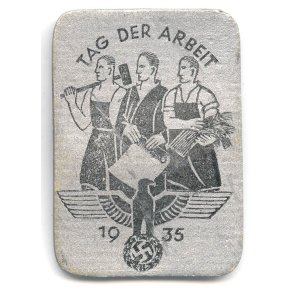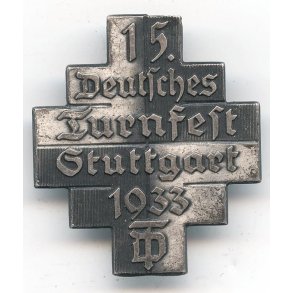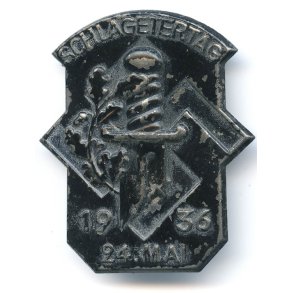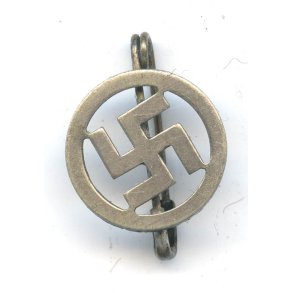Nat. Soz. Frauenschaft member's badge.
Maker marked 'RZM 75' indicating that it was produced by the company Otto Schickle, Pforzheim
RZM transitional-period manufactured badge, meaning that it was produced 1933-1935.
Excellent to near mint condition, look great in hand. No enamel damages.
Size roughly 44x40 mm. Meaning that this is the largest badge in this series.
----------------------------
INFO ABOUT THIS BADGE:
The Women’s Order of the Red Swastika was a triangular metal pin, slightly arched, showing a white enamel cross on a glossy black enamel background, with a red swastika at the center of the cross and nickel silver letters “G”, “H”, “L” on the cross arms and foot (in gothic font). A white band runs across the top with the words “NAT. SOZ. FRAUENSCHAFT” in silver, Roman font. This type of pin has various markings on the back ranging from “Ges. Gesch.” (Patented), to an RZM mark and maker code or a maker’s name. The large version of this pin is in fact the largest pin of any type used by any sub-agency of the NSF.
HISTORY:
The NSF was formed in 1931, after Gregor Strasser disbanded a number of competing socialist women’s organizations (among these the DFO - Deutsche Frauenordens) and unified them into the only women’s organization thenceforth recognized by the NSDAP as being distinctly National Socialist-oriented. This was called the National Sozilialistische Frauenschaft. Nearly all of these women were highly sympathetic to the Nazi party, if not Party Members. Other women’s groups not specifically allied with the Nazi party fell under the auspices of the “Deutsche Frauenwerks” (DFW) – the Women’s Welfare Organization.
In addition, there was also a women’s bureau within the DAF organization. In 1934, Mrs. Gertrud Klink-Scholz, a schoolteacher and journalist, was named as the first (and only) Reichsführerin (National Leader) of the NSF, as well as Leiterin (Director) of the DFW. Mrs. Scholz had been an NSDAP lobbyist and supporter from the early days (joined in 1929) and her rise had been fairly meteoric; that same year she was also made leader of the National Women’s League of the German Red Cross and Director for the Women’s Bureau of the DAF. Mrs. Scholz had now effectively become the most influential woman in the Reich. In 1940 after a divorce from second husband Scholz (first husband Klink died of a heart attack in 1930), she re-married -Obergruppenführer and General of Police Heißmeyer (who was the head of the NS Adolf Hitler School). Frau Scholz survived the war, but spent post-war time in prison for aiding the Nazis. Part of her punishment included being banned from the teaching or journalism professions for life.
In 1935, the NSF became an official party organ of the NSDAP. It had a triangular membership pin, (the point oriented downward). From 1935, the NSF’s structure was organized in the same manner and using the same associated level colors as the country’s political / administrative structure – that is, REICH Level (the highest), with yellow insignia edges, GAU Level with red insignia edges, KREIS Level with white insignia edges (black on early pins; this color was changed to white in 1938) and ORT Level, with blue insignia edges. Leadership positions usually involved adding an extra border in silver, around the outside of the pin and for higher leaders, a silver oak leaf border. Early pins were beautifully made in fine quality enamels with nickel-silver; late-war pins were often made of zinc, with the colors painted.
At the high point of the Third Reich with some 4 million organized women, approximately 2.3 million of these were NSF members. These pins are a unique collectible; the NSF organizational system was complex and this offers a great deal of room for various collecting tastes.




